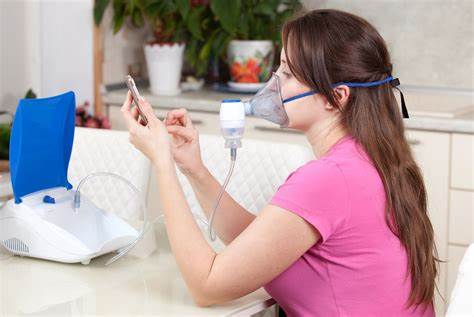Nebuliser therapy is a widely used and effective treatment for respiratory conditions, providing much-needed relief for individuals struggling with breathing difficulties. In this blog, we will explore how nebuliser therapy works, the conditions it helps treat, its benefits, and much more.
What is Nebuliser Therapy?
Nebuliser therapy is a medical treatment that uses a nebuliser machine to deliver medication in the form of a mist directly into the lungs. It works by turning liquid medication into a fine mist, which can be inhaled through a mouthpiece or mask. This method allows the medication to work more quickly and effectively compared to oral medication, making it especially useful for respiratory conditions that require fast-acting relief.
Common medications used in nebuliser therapy include bronchodilators, steroids, and antibiotics. These medications help open up the airways, reduce inflammation, and prevent infections.
Types of Respiratory Conditions Treated by Nebulisers
Nebuliser therapy is commonly used to treat several respiratory conditions, especially those that cause breathing difficulties. Some of the most common conditions include:
Asthma
A chronic disease that inflames and narrows the airways, leading to wheezing, shortness of breath, and coughing. Nebuliser therapy helps manage asthma flare-ups and reduce symptoms.
Chronic Obstructive Pulmonary Disease (COPD)
A group of lung diseases that block airflow and make breathing difficult. Nebuliser treatment can help manage symptoms like shortness of breath and cough.
Cystic Fibrosis
A genetic disorder that affects the lungs and digestive system, making it harder to breathe. Nebuliser therapy can deliver medications that help clear mucus from the lungs.
Pneumonia
An infection that inflames the air sacs in one or both lungs. Nebulisers can deliver antibiotics or other medications to ease symptoms and improve breathing.
Other conditions like bronchitis, emphysema, and lung infections can also benefit from nebuliser therapy.
Benefits of Nebuliser Therapy
Nebuliser therapy offers numerous benefits, especially for patients who have difficulty using inhalers. Some key advantages include:
Effective Medication Delivery
Nebuliser therapy allows medication to be delivered directly to the lungs, ensuring that the medicine reaches the area where it’s needed most. This method is often more effective than oral medication for respiratory conditions.
Faster Relief of Symptoms
Nebulisers work quickly, providing relief for shortness of breath, wheezing, and coughing, especially during an asthma or COPD flare-up.
Ease of Use
Unlike inhalers, which require specific techniques to use properly, nebulisers are easy to operate and are ideal for children, the elderly, or patients with limited dexterity.
Continuous Medication Delivery
Nebulisers provide a steady flow of medication over a longer period, making it easier for the body to absorb and respond to treatment.
How to Use a Nebuliser
Using a nebuliser correctly is essential for optimal results. Here’s a step-by-step guide:
- Prepare the Nebuliser: Start by assembling the nebuliser machine, attaching the nebuliser cup, and connecting it to the air compressor.
- Add Medication: Pour the prescribed medication into the nebuliser cup. Be sure to follow your healthcare provider’s instructions on dosage.
- Attach the Mask or Mouthpiece: Put the mask over your nose and mouth, or use the mouthpiece to inhale the mist.
- Turn On the Nebuliser: Once everything is in place, turn on the nebuliser and breathe in the mist. Take slow, deep breaths until all the medication is used up (usually 10-15 minutes).
- Clean the Nebuliser: After each use, thoroughly clean the nebuliser components to prevent bacteria growth and ensure proper functioning.
Nebuliser vs. Inhalers: Key Differences
While both nebulisers and inhalers are used to deliver medication for respiratory conditions, they differ in several ways:
- Ease of Use: Nebulisers are easier to use, especially for those with breathing difficulties, children, or elderly patients. Inhalers require specific techniques and a firm breath to ensure proper delivery of medication.
- Speed of Delivery: Nebulisers deliver medication continuously over a longer period, while inhalers release a single dose of medication with each puff.
- Effectiveness: For severe symptoms, nebulisers can be more effective as they provide a larger dose of medication directly to the lungs.
Side Effects and Considerations
Like all treatments, nebuliser therapy may come with some side effects. Common side effects include:
- Coughing: Some individuals may experience coughing after using a nebuliser due to the mist.
- Throat Irritation: The mist may cause mild irritation or dryness in the throat.
- Nausea: Rarely, some people may feel nauseous after using a nebuliser.
If you experience any unusual side effects or worsening symptoms, it’s important to consult your healthcare provider.
Choosing the Right Nebuliser
There are different types of nebulisers available, including:
- Compressor Nebulisers: These are the most common and use air pressure to create a mist from liquid medication.
- Ultrasonic Nebulisers: These use high-frequency sound waves to create the mist, making them quieter and more portable.
- Mesh Nebulisers: These are compact and efficient, using a mesh to generate the mist. They are ideal for on-the-go use.
When choosing a nebuliser, factors like portability, ease of cleaning, noise level, and the type of medication you use should be considered.
Who Should Consider Nebuliser Therapy?
Nebuliser therapy is suitable for individuals with chronic respiratory conditions who have difficulty using inhalers or require continuous medication delivery. It’s especially beneficial for:
- Children: Nebulisers are easier to use for children who may not be able to use inhalers effectively.
- Elderly Patients: Older adults who may struggle with inhalers can benefit from the ease of nebuliser therapy.
- Severe Respiratory Conditions: Patients with severe asthma, COPD, or other lung diseases often require nebuliser therapy for effective symptom management.
Conclusion
Nebuliser therapy offers effective and fast relief for individuals suffering from respiratory conditions like asthma, COPD, and cystic fibrosis. It provides several benefits, including better medication delivery and ease of use, especially for those who have difficulty using inhalers. If you or a loved one suffers from a respiratory condition, consult a healthcare provider to determine if nebuliser therapy is the right treatment option.

